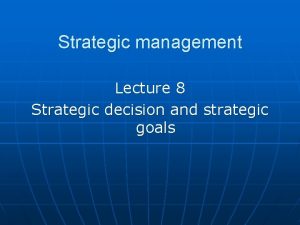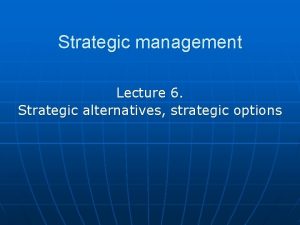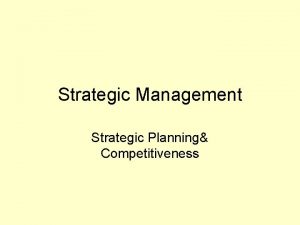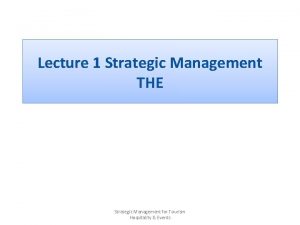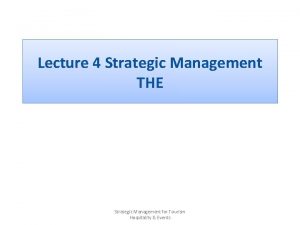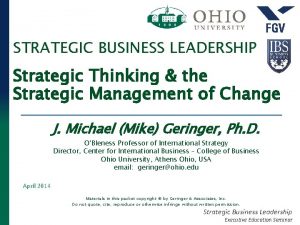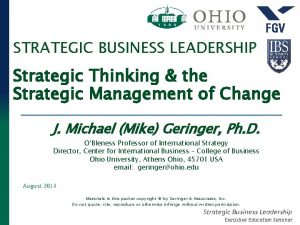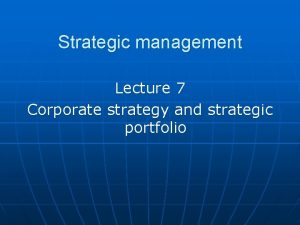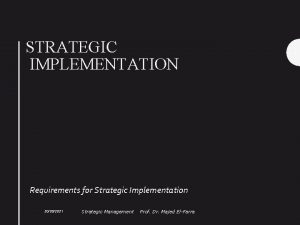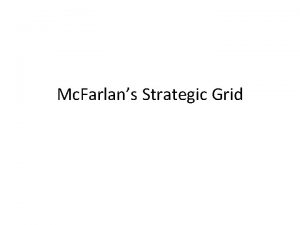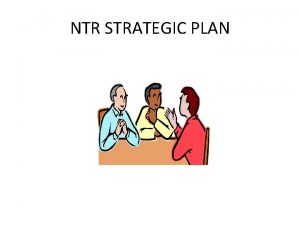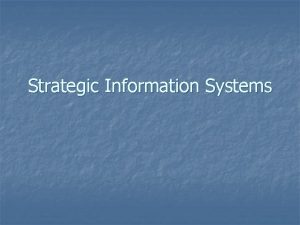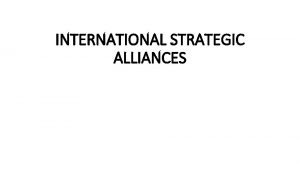Lecture 3 Strategic Management THE Strategic Management for







































- Slides: 39

Lecture 3 Strategic Management THE Strategic Management for Tourism Hospitality & Events

The Human Context Strategic Management for Tourism Hospitality & Events

Introduction In this session: • • importance of human resources in THE; employment and working conditions in THE; the guest–employee encounter; service quality; the human resource audit; critical success factors; organisational culture; cross-cultural differences. Strategic Management for Tourism Hospitality & Events

Human Resources Why are they so important? • THE is often highly labour-intensive. • Human resources are often the key differentiator between different competing organisations. • the human element in THE organisations is critical for: – – – service quality; customer satisfaction; loyalty; competitive advantage; organisational performance; • interaction between guests and employees: – is highly important and can be viewed as part of the product; – is often with relatively junior ‘front-line’ staff. Strategic Management for Tourism Hospitality & Events

Human Resources in THE Workforce has distinctive features • THE workforce is often characterised by: large proportion of female and young employees; large number of part-time and seasonal workers; high staff turnover rates; recruitment difficulties; poor levels of training; relatively low pay; labour mobility between different employers and geographically; – employees working remotely; – working patterns involving work at nights and weekends; – importance of volunteers particularly for large events. – – – – • Each characteristic raises challenges for managers. Strategic Management for Tourism Hospitality & Events

Employee Recruitment, Retention and Motivation Motivate and empower THE staff • some perceived negative aspects of THE employment in some cases; • also staff often working remotely or at times when managers are not available; • to deal with these factors employers may offer: – – training opportunities; career progression opportunities; travel incentives; higher levels of pay and bonuses; • Critically though, employers need to pay attention to the design of jobs and employee empowerment. Strategic Management for Tourism Hospitality & Events

Job Design and Empowerment Critical aspects of HRM in THE • pay attention to design of jobs and roles through measures such as: – job enlargement – employees given a wider variety of tasks; – job rotation – employees rotate jobs; – job enrichment – employees given more discretion or empowerment to make decisions; – job sharing – employees’ jobs shared between two or more employees; • many THE employers stress importance of empowering employees; – so they can take decisions and resolve issues as they occur; – within pre-set guidelines. Strategic Management for Tourism Hospitality & Events

Empowerment Empowering employees How can empowerment enhance the quality experience of customers in - Tourism - Hospitality - Events ? PLEASE THINK ABOUT AND NOTE DOWN ONE EXAMPLE FOR EACH OF THE THREE INDUSTRIES Strategic Management for Tourism Hospitality & Events

The Guest–Employee Encounter Front-line employees are vital • managing the guest (customer)–employee encounter: – difficult but highly important for THE managers; – for customers service quality is judged by the service encounter or the moment of truth; • in THE managing the encounter is made more challenging because of: – the fragmentation of customers’ experience; – employees working remotely. Strategic Management for Tourism Hospitality & Events

Service Quality Source of competitive advantage • Service quality is often important in gaining competitive advantage in THE. – largely determined by the quality of human resources; – because they facilitate firm specific competencies; • services are intangible; produced and consumed simultaneously; usually with interpersonal interaction between customers and service providers, and thus: – services are made tangible in the personality, appearance, attitudes, and behaviour of employees; – employees become part of the product, represent the organisation, and help to form the image of the organisation. Strategic Management for Tourism Hospitality & Events

High quality human resources Service quality Business success Competitive advantage Customer satisfaction and Loyalty The ‘virtuous circle’ linking human resources with business success Strategic Management for Tourism Hospitality & Events

Service Quality Gaps Achieving customer satisfaction • SERVQUAL model of service quality (Zeithaml et al. , 1990) Strategic Management for Tourism Hospitality & Events

Service Quality Gaps Achieving customer satisfaction • SERVQUAL model of service quality (Zeithaml et al. , 1990): • service quality gap – perception of service received is less than what is expected; five service dimensions: – – – Responsiveness – willingness to help customers; Assurance – knowledge and courtesy of employees; Tangibles – appearance of physical facilities; Empathy – caring, individualised attention; Reliability – ability to perform dependably; • possible service quality gaps: – gap 1: management does not know what guests expect; – gap 2: management is not willing or able to put the systems in place to match or exceed customer expectations; – gap 3: the service–performance gap – employees are unable and/or unwilling to perform the service at the desired level; – gap 4: promises do not match delivery. Strategic Management for Tourism Hospitality & Events

Service Quality Gaps How can gaps be closed? • Gaps may be positive or negative. – e. g. surpluses or deficiencies of a particular type of employee; – The strategy thus has to relieve labour surpluses or recruit additional labour. • Gaps may be closed by using the ‘five Rs’ individually or in combination. The five Rs are: – – – Retirement Retraining Redeployment Redundancy Recruitment. Strategic Management for Tourism Hospitality & Events

Human Resource Audit Can human resources implement strategy? • investigation into size, skills, structure and all other issues of those currently employed; • Assess the ability of human resources to implement a chosen strategy or range of strategic options. • typical audit checklist: – – – – – number of employees; employee costs; organisational structure; recruitment and selection procedures; quality and effectiveness of training and development; employee motivation and morale; quality of employee or industrial relations; internal and external networks of employees; effectiveness of human resource policies and control procedures. Strategic Management for Tourism Hospitality & Events

Critical Success Factors Some human resources may be critical • As well as identifying gaps, HR audit may establish which employees or groups are critical to strategic success. • Usually there are one or more reasons why some organisations have superior performers. • Key reasons for success are called Critical Success Factors (CSFs). • CSFs may lie in several areas – but often human resources often form a part. • e. g. some companies may have: – uniquely skilled employees; – employees with exceptional knowledge and experience; – an inspirational leader. Strategic Management for Tourism Hospitality & Events

Organisational Culture • Is the culture – organisational equivalent of a human’s personality; • As with human personality, culture can be difficult to explain andf define. Consequently there are many definitions. • Culture can be explained in terms of the ‘feel’ of an organisation or its ‘character’ or ‘the way we do things round here’. • A strategically important point is that all organisations have a culture that it can have a significant effect on organisational performance. • THE managers: – must attempt to understand the culture; – and the effect it is has (positive or negative) on organisational performance; – Managers may subsequently need to take steps to implement a Strategic Management for Tourism programme that attempts to change the prevailing culture to Hospitality & Events improve performance.

The Determinants of Culture Many possible influences • philosophy of the organisation’s founders, especially if it is relatively young; • nature of activities and character of industry it competes in; • nature of the interpersonal relationships and the nature of industrial or employee relationships; • management style adopted and types of control mechanism, e. g. existent management style is autocratic or democratic; • national or regional character of areas where organisation’s activities are located. in turn, this can affect the power distance, which also influences culture; • structure of organisation, particularly its ‘height’ and ‘width’; • dependency on technology and the type of technology Strategic Management for Tourism employed. Hospitality & Events

Importance of Culture can have broad influences • culture can have an influence on: – employee motivation; – attractiveness as an employer and hence the rate of staff turnover; – employee morale and ‘goodwill’; – productivity and efficiency; – quality of work; – nature of industrial relations; – attitude of employees in the workplace; – innovation and creativity; • Many THE organisations have recognised the importance of a strong and consistently applied culture. • can enable organisations to strive to deliver: – consistent standards of service; – can be used as a promotional tool externally and internally. Strategic Management for Tourism Hospitality & Events

The Cultural Web Strategic Management for Tourism Hospitality & Events

The Cultural Web Elements of the web • stories – what people within the organisation talk to each other about; • routines and rituals – routines are procedures for doing things; rituals have longer time frame and can be either formal or informal; • symbols – aspects that symbolise something to some people; • structure – can mean more than just those formal relationships shown on an organisation diagram; • control systems – ways in which activities are controlled; • power structures – core assumptions that contribute to the paradigm are likely to be made by the most powerful management; • paradigm – the aggregate effects of the all of the cultural Strategic Management for Tourism influences on the way the organisation looks at the world. Hospitality & Events

Hofstede’s Cross-Cultural Differences Cultural dimensions theory • THE is, by its nature, international in orientation. • thus it is important that THE managers understand: – – the influence of national culture; the effects the differences have upon the successful implementation of strategy; • Hofstede’s cultural dimensions theory presents five dimensions: – – – Power distance Individualism/collectivism Masculinity versus femininity Uncertainty avoidance Long-termism versus short-termism. Strategic Management for Tourism Hospitality & Events

SUMMARY • THE is often highly labour-intensive and human resources are often the key differentiator between organisations. • The THE workforce often has particular characteristics. • Front-line employees are vital in creating and maintaining service quality. • Service quality is linked to business success through the HR virtuous circle. • SERVQUAL – model of service quality; • HR audit allows gaps and CSFs to be identified. • Culture has an effect upon performance.

Tourism, Hospitality and Event Organisations The Operational Context: Competencies, Resources and Competitive Advantage Strategic Management for Tourism Hospitality & Events

Introduction In this session: • • the sources of competitive advantage; resource analysis; competencies and core competencies; analysis outcomes; value adding activities; the service profit chain; the (pims) study; service dominant logic. Strategic Management for Tourism Hospitality & Events

Competitive Advantage • It is often seen as the overall purpose of strategy. • In commercial settings it is usually viewed as returning higher profits than competitors. – Higher profits allow more to be retained to reinvest in its strategy, thus maintaining a lead over competitors. – When the superiority is maintained over time, sustainable competitive advantage is achieved. – To be sustainable the advantage must be able to resist the actions of rivals. Strategic Management for Tourism Hospitality & Events

Sources of Competitive Advantage Why are some organisations more successful? • In strategy this is usually associated with achieving competitive advantage and faster growth than competitors. • Previously we stressed the importance of context, but other factors have to be considered in any context. Strategic Management for Tourism Hospitality & Events

Sources of Competitive Advantage How is competitive advantage achieved • The sources of achieving competitive advantage in any industry lie in: – the superior application of competencies (skills); – the deployment of superior resources (assets); – creating value for consumers. Strategic Management for Tourism Hospitality & Events

Resource Analysis Some resources are easier to analyse than others • Resources can be tangible or intangible. • tangible – obtained from outside organisations in resource markets in competition with others; • intangible – often developed within an organisation; – have a value (often difficult to quantify or even identify) which can be bought and sold in markets; • Relationships with resource suppliers can be a part of the organisation’s core competence. Strategic Management for Tourism Hospitality & Events

Resources in THE Are some resources free? • THE is different from most other industries in that free resources are often vital. – available freely with unlimited supply and not requiring a market to allocate them, e. g. air, sea and scenery; – have to be utilised carefully in a sustainable way; • All resources have competing demands. – If they are used in one way they cannot be used in another. Strategic Management for Tourism Hospitality & Events

Resources in THE Key resource considerations in THE • resource immobility; – Many resources that are used cannot be moved either in terms of place or time. • resource substitution; – often difficult to substitute one resource category with another; • resource conflict and competition; – often in conflict or competition with other users; • resource ownership and control; – utilise resources that are neither owned nor controlled. Strategic Management for Tourism Hospitality & Events

Resources in THE Some further considerations • seasonality of resource utilisation; – Many THE activities are highly seasonal. • low rewards for resources; – sometimes only able to offer relatively low rewards; • capacity; – resource capacity often constrained in some way; • time; – Consumers have to give up their scarce resource-time. Strategic Management for Tourism Hospitality & Events

Analysing Resources There are different ways: • analysis by category; – physical, operational, human, financial and intangible resources; • analysis by specificity; – Resources can be specific or non-specific. • analysis by performance; – How do they contribute to internal and external measures of performance? – Organisations can internally and externally benchmark performance as to stimulate improvements. Strategic Management for Tourism Hospitality & Events

Competencies and Core Competencies What are you good at? • Competencies; – Attributes such as skills, knowledge, technology and relationships that are common among competitors in an industry; • Core competencies are attributes distinguished from competencies. – Performance is superior to industry average. – unique to the company; – more complex; – difficult to emulate (copy); – relate to fulfilling specific customer needs; – add greater value than competencies; – distinctive relationships with customers, distributors and suppliers; Strategic Management for Touri. Hospitality & Evandnts – superior organisational skills and knowledge.

Analysis Outcomes What does resource and competency analysis add to our understanding? • The aim of an analysis of resources, competencies and core competencies is to understand the: – nature of the resources on which the organisation depends; – nature and sources of particular core competencies; – need for adaptation of existing core competencies; – need for new core competence building; – potential sources of core competence based on resources and competencies; – need for core competencies to remain focused on customer needs. Strategic Management for Tourism Hospitality & Events

Value What is it and how can we add to it? • value – the difference in value of the product compared to the value of the inputs. It can be increased by: – charging customers a higher rate; – reducing costs below those of competitors; • clear links between value-adding activities, core competencies, competencies and resources; – resources form inputs to the value-adding activities; – Competencies and core competencies provide the attributes to carry out the value-adding activities. – Greater value will be added the more that core competencies can be added to activities. Strategic Management for Tourism Hospitality & Events

Outsourcing Used by many THE organisations • outsourcing – entrusting some of an organisation’s activities to an external entity; • Organisations concentrate on core activities associated with core competencies. • Activities which are not regarded as core are outsourced. – Combined complementary core competencies add to competitive advantage for all collaborators. – Value chain analysis can identify where outsourcing might add greater value. Strategic Management for Tourism Hospitality & Events

Other Approaches Other important contributions • the service profit chain emphasises: – the roles of employees internally to the organisation; – the way in which services are delivered; – targeting of marketing to customers’ needs; • the Profit Impact of Market Strategy (PIMS) study: – key finding: a primary determinant of profitability is market share; • service dominant logic focuses on: – intangible rather than tangible resources; – cocreation of value rather than embedded value; – relationships rather than transactions. Strategic Management for Tourism Hospitality & Events

SUMMARY • THE organisations have to try to configure and coordinate their operational resources and processes in such a way that they add value. • In so doing they achieve an advantage over competitors – competitive advantage. • It is very important in the strategy to have a good understanding of the resources they have available to them and how these are used to create value. • Analysis indicates where strategy needs to focus. • It is also necessary to consider the potential for collaboration with suppliers, distributors and customers
 01:640:244 lecture notes - lecture 15: plat, idah, farad
01:640:244 lecture notes - lecture 15: plat, idah, farad Strategic management lecture
Strategic management lecture Industrial organization model of above average returns
Industrial organization model of above average returns Strategy analysis and choice largely involves making
Strategy analysis and choice largely involves making Fspos
Fspos Typiska novell drag
Typiska novell drag Nationell inriktning för artificiell intelligens
Nationell inriktning för artificiell intelligens Ekologiskt fotavtryck
Ekologiskt fotavtryck Varför kallas perioden 1918-1939 för mellankrigstiden?
Varför kallas perioden 1918-1939 för mellankrigstiden? En lathund för arbete med kontinuitetshantering
En lathund för arbete med kontinuitetshantering Underlag för särskild löneskatt på pensionskostnader
Underlag för särskild löneskatt på pensionskostnader Personlig tidbok för yrkesförare
Personlig tidbok för yrkesförare A gastrica
A gastrica Densitet vatten
Densitet vatten Datorkunskap för nybörjare
Datorkunskap för nybörjare Stig kerman
Stig kerman Att skriva en debattartikel
Att skriva en debattartikel Delegerande ledarstil
Delegerande ledarstil Nyckelkompetenser för livslångt lärande
Nyckelkompetenser för livslångt lärande Påbyggnader för flakfordon
Påbyggnader för flakfordon Formel för lufttryck
Formel för lufttryck Publik sektor
Publik sektor Kyssande vind analys
Kyssande vind analys Presentera för publik crossboss
Presentera för publik crossboss Jiddisch
Jiddisch Vem räknas som jude
Vem räknas som jude Treserva lathund
Treserva lathund Fimbrietratt
Fimbrietratt Claes martinsson
Claes martinsson Cks
Cks Programskede byggprocessen
Programskede byggprocessen Bra mat för unga idrottare
Bra mat för unga idrottare Verktyg för automatisering av utbetalningar
Verktyg för automatisering av utbetalningar Rutin för avvikelsehantering
Rutin för avvikelsehantering Smärtskolan kunskap för livet
Smärtskolan kunskap för livet Ministerstyre för och nackdelar
Ministerstyre för och nackdelar Tack för att ni har lyssnat
Tack för att ni har lyssnat Referatmarkeringar
Referatmarkeringar Redogör för vad psykologi är
Redogör för vad psykologi är Matematisk modellering eksempel
Matematisk modellering eksempel











































